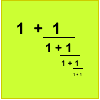Skip over navigation
Here is another excellent solution from Andrei of Tudor Vianu National College, Bucharest, Romania.
We are given $F_n={1\over\sqrt5}(\alpha^n-\beta^n)$ where $\alpha$ and $\beta$ are solutions of the quadratic equation $x^2-x-1=0$ and $\alpha > \beta$.
(1) In the quadratic equation $ax^2+bx+c=0$ with roots $\alpha$ amd $\beta$, using Viete's relations for the sum and product of the roots, I obtain: $\alpha\beta =-b/a$, $\alpha + \beta = c/a$
In the particular case of the equation $x^2-x-1=0$, I have: $\alpha\beta =-1$, $\alpha + \beta = 1$
(2)$${1\over \alpha} + {1\over \alpha^2}={\alpha + 1\over \alpha^2}=1$$ as $\alpha$ satisfies $x^2=x+1$. Similarly for $\beta$.
(3) Here I shall prove that $F_1=1$, $F_2=1$ and $F_n + F_{n+1} = F_{n+2}$ and hence $F_n$ is the $n$th Fibonacci number. First, I calculate $\alpha$ and $\beta$: $\alpha={1+\sqrt5\over 2}$ and $\alpha={1+\sqrt5\over 2}$
$$\begin{eqnarray} F_1 &= {1\over \sqrt 5}\left( {1+\sqrt 5 \over 2} - {1-\sqrt 5 \over 2}\right) = 1 \\ F_2 &= {1\over \sqrt 5}(\alpha^2 - \beta^2) = {1\over \sqrt 5} (\alpha - \beta)(\alpha + \beta) = 1 \\ F_n +F_{n+1}- F_{n+2}&= {1\over \sqrt 5}[\alpha^n -\beta^n + \alpha^{n+1} -\beta^{n+1} - \alpha^{n+2} + \beta^{n+2}] \\ F_n + F_{n+1}- F_{n+2}&= {1\over \sqrt 5}[-\alpha^n(\alpha^2 - \alpha - 1) +\beta^n(\beta^2- \beta -1)]=0\end{eqnarray}$$
(4) I shall prove by induction the statement $P_n$ that $1 + F_1 + F_2 + \cdots F_n = F_{n+2}$.
I know that $F_1=1, F_2=1$ and by (3), $F_3=2, F_4=3, F_5=5, F_6=8,...$\\ For $n=1$, $P_1$ is $1+ F_1 = F_3$ which is evidently true as 1 + 1 = 2.
For $n=2$, $P_1$ is $1+ F_1 + F_2= F_4$ which is evidently true as 1 + 1 + 1 = 3.
For $n=3$, $P_1$ is $1+ F_1 + F_2 + F_3 = F_5$ which is evidently true as 1 + 1 + 1 + 2 = 5.
Now I assume that $P(k)$ is true for a fixed $k$ and I shall prove that $P(k+1)$ is also true, that is:
$$\begin{eqnarray} P_k &: 1 + F_1 + F_2 + \cdots F_k = F_{k+2} \\ P_{k+1}&: 1 + F_1 + F_2 + \cdots F_k + F_{k+1} = F_{k+3}\end{eqnarray}$$
$$\begin{eqnarray}1 + F_1 + F_2 + \cdots F_k + F_{k+1}&= (1 + F_1 + F_2 + \cdots F_k ) + F_{k+1}\\ &= F_{k+2} + F_{k+1} \\ &= F_{k+3}\end{eqnarray}$$
and hence the result is true for $n=k+1$. By the principle of mathematical induction the statement $P_n$ is true for all positive integer values of $n$ which completes the proof.


Or search by topic
Number and algebra
Geometry and measure
Probability and statistics
Working mathematically
Advanced mathematics
For younger learners
Fibonacci Fashion
Age 16 to 18
Challenge Level 





- Problem
- Getting Started
- Student Solutions
- Teachers' Resources
Here is another excellent solution from Andrei of Tudor Vianu National College, Bucharest, Romania.
We are given $F_n={1\over\sqrt5}(\alpha^n-\beta^n)$ where $\alpha$ and $\beta$ are solutions of the quadratic equation $x^2-x-1=0$ and $\alpha > \beta$.
(1) In the quadratic equation $ax^2+bx+c=0$ with roots $\alpha$ amd $\beta$, using Viete's relations for the sum and product of the roots, I obtain: $\alpha\beta =-b/a$, $\alpha + \beta = c/a$
In the particular case of the equation $x^2-x-1=0$, I have: $\alpha\beta =-1$, $\alpha + \beta = 1$
(2)$${1\over \alpha} + {1\over \alpha^2}={\alpha + 1\over \alpha^2}=1$$ as $\alpha$ satisfies $x^2=x+1$. Similarly for $\beta$.
(3) Here I shall prove that $F_1=1$, $F_2=1$ and $F_n + F_{n+1} = F_{n+2}$ and hence $F_n$ is the $n$th Fibonacci number. First, I calculate $\alpha$ and $\beta$: $\alpha={1+\sqrt5\over 2}$ and $\alpha={1+\sqrt5\over 2}$
$$\begin{eqnarray} F_1 &= {1\over \sqrt 5}\left( {1+\sqrt 5 \over 2} - {1-\sqrt 5 \over 2}\right) = 1 \\ F_2 &= {1\over \sqrt 5}(\alpha^2 - \beta^2) = {1\over \sqrt 5} (\alpha - \beta)(\alpha + \beta) = 1 \\ F_n +F_{n+1}- F_{n+2}&= {1\over \sqrt 5}[\alpha^n -\beta^n + \alpha^{n+1} -\beta^{n+1} - \alpha^{n+2} + \beta^{n+2}] \\ F_n + F_{n+1}- F_{n+2}&= {1\over \sqrt 5}[-\alpha^n(\alpha^2 - \alpha - 1) +\beta^n(\beta^2- \beta -1)]=0\end{eqnarray}$$
(4) I shall prove by induction the statement $P_n$ that $1 + F_1 + F_2 + \cdots F_n = F_{n+2}$.
I know that $F_1=1, F_2=1$ and by (3), $F_3=2, F_4=3, F_5=5, F_6=8,...$\\ For $n=1$, $P_1$ is $1+ F_1 = F_3$ which is evidently true as 1 + 1 = 2.
For $n=2$, $P_1$ is $1+ F_1 + F_2= F_4$ which is evidently true as 1 + 1 + 1 = 3.
For $n=3$, $P_1$ is $1+ F_1 + F_2 + F_3 = F_5$ which is evidently true as 1 + 1 + 1 + 2 = 5.
Now I assume that $P(k)$ is true for a fixed $k$ and I shall prove that $P(k+1)$ is also true, that is:
$$\begin{eqnarray} P_k &: 1 + F_1 + F_2 + \cdots F_k = F_{k+2} \\ P_{k+1}&: 1 + F_1 + F_2 + \cdots F_k + F_{k+1} = F_{k+3}\end{eqnarray}$$
$$\begin{eqnarray}1 + F_1 + F_2 + \cdots F_k + F_{k+1}&= (1 + F_1 + F_2 + \cdots F_k ) + F_{k+1}\\ &= F_{k+2} + F_{k+1} \\ &= F_{k+3}\end{eqnarray}$$
and hence the result is true for $n=k+1$. By the principle of mathematical induction the statement $P_n$ is true for all positive integer values of $n$ which completes the proof.
You may also like
Continued Fractions I
An article introducing continued fractions with some simple puzzles for the reader.
Fibonacci Factors
For which values of n is the Fibonacci number fn even? Which Fibonnaci numbers are divisible by 3?

